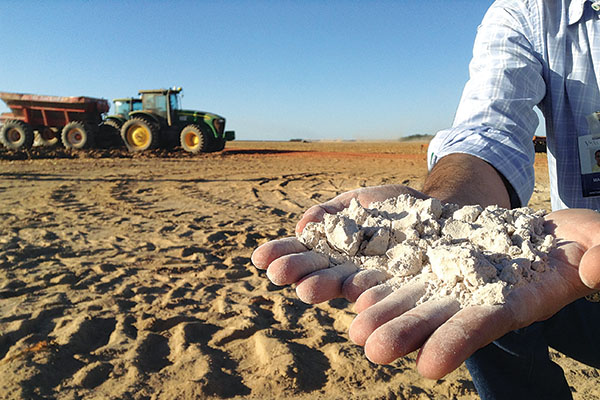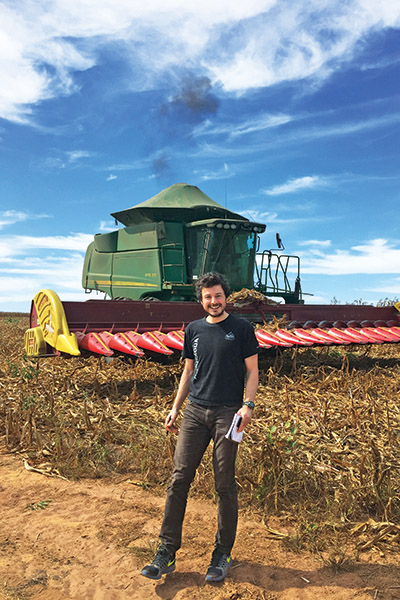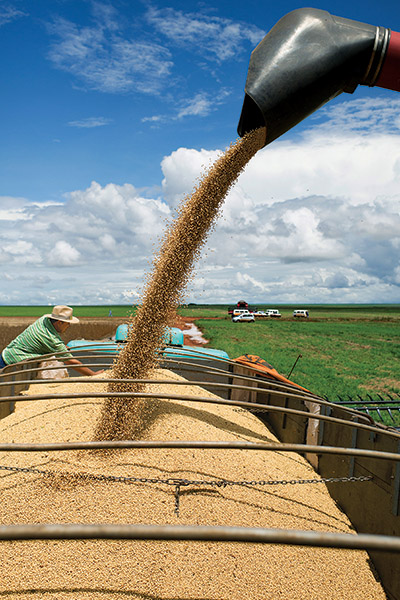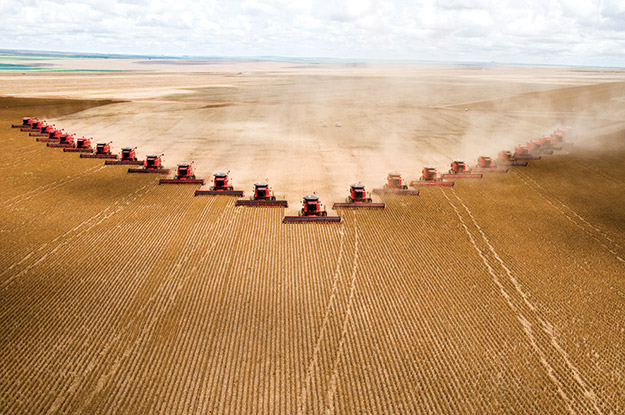This article is adapted from AQ’s most recent issue, “Fixing Brazil.” To receive the print edition at home, subscribe here.
In 1979, Brazilian rancher Flavio Turquino purchased 54,000 acres deep inside Mato Grosso, a landlocked state whose name means “thick forest,” for about $1 an acre. He had already scouted the land in his single-prop Cessna and marked the coordinates for where to build a farmhouse. But first he needed a road. So he rented a tractor and carved a 25-mile trail to the area, cleared it for pasture, and marched a herd of cattle from more than 300 miles away.
Today, the farm still feels like the frontier of Brazil’s frontier. Surrounding roads turn to porridge during the rainy season and kick up thick clouds of dust during the dry months, blotting out the sun and forcing cars and trucks to drive with their headlights on high beam to see one another. It takes as long as five hours to drive 25 miles into the town of Feliz Natal, or “Merry Christmas” — so named because a group of Turquino’s farmhands got stuck in the mud there one December 25.
Asphalt is a convenience that farmers must do without in a state where fewer than a quarter of roads are paved, and if only the challenges stopped there: Just 12 percent of Turquino’s land is being farmed because of a decade-long bureaucratic delay in gaining permission to clear new land. Poor infrastructure prevents farmers from reaching nearby Amazon ports, pushing them to crowded southern ports that are 20 times more expensive to use.
“You’re always losing money because of this nonsense,” said Turquino’s oldest daughter, Giselle, who runs the farm these days.
The good news: Conditions appear ripe for Brazil to start tackling some of the “nonsense” holding back the Turquinos and other farmers. The country’s worst economic crisis on record has exposed the limitations of the policies that prevailed over the past 15 years and changed the priorities of many politicians in Brasília and Cuiabá, Mato Grosso’s state capital. There is a growing consensus that, with Brazilian consumers mired in debt, industry stuck in a decade-long slump, and new global trade deals unlikely, agribusiness might be the best available growth engine for Latin America’s biggest economy for years to come.
“Brazil won’t survive this crisis without the agriculture sector,” said Thomas Traumann, a political analyst based in Rio de Janeiro. He said new President Michel Temer knows this, but high fiscal deficits will prevent Temer, and possibly his successor as well, from undertaking any huge new programs to build ports and highways. So solutions probably lie instead with improving the terms for public-private partnerships for infrastructure, cutting Brazil’s notoriously awful red tape, and making other relatively low-cost fixes. If executed correctly, these smaller initiatives — while less sexy than, say, a new railroad — could prove almost as transformative.

The potential of the sector is clear — the Turquino farm’s land alone is now valued at about $18.5 million, an incredible creation of wealth in just four decades. Mato Grosso is one of the few places in the world where it’s possible to harvest two crops in a single season without irrigation, thanks to a long rainy season and consistent sunshine. The flat topography enables efficient harvesting on a grand economy of scale. Over the past decade, Mato Grosso has become the leading producer of soy, corn, cattle, and cotton in Brazil, which in turn is a top global exporter of all four products. Albert Fishlow, a legendary Brazil-follower at Columbia University, said agribusiness is the only sector of the economy to see productivity gains over the last 30 years.
During a two-week visit to several farms, I saw clear examples of how agribusiness could kick into an even higher gear in the years ahead. But I also saw unfinished highways, the real-life consequences of corruption, and some of the most maddening, illogical bureaucracy you could imagine. Perhaps most inspiring were the local farmers, teachers and officials who have grown tired of waiting for Brasília to act, and are finding creative ways to solve problems themselves.
Saved by Soy
On my way to the Turquino farm, was constantly gripping my seat to brace for the impact of the next Mack truck that might suddenly emerge from the clouds of dust and collide with my tiny Subaru. After hours of tension, the farmhouse tucked in the shade of parakeet-filled trees looked like an oasis.
Giselle Turquino, 50, greeted me on the porch with fresh-squeezed tangerine juice. Like much of Mato Grosso, her farm technically sits within Brazil’s Amazon region — which explains the longstanding misgivings of conservationists about the expansion of agriculture here. We were also sitting mere miles from a huge indigenous reserve, Parque Indígena do Xingu. Artifacts such as a bow and arrow decorate the farmhouse, thanks to indigenous people who occasionally come into town to trade.
 As I began asking questions, Turquino took out a box of old black-and-white photos that told an epic family history. Her father named the farm Uirapuru, after the Brazilian bird whose song is said to bring good fortune. But the land had no uirapuru, nor did he seem to have any luck. The acidic soil could not sustain pasture, and within a decade the cattle were sold and the fields had become scrubland.
As I began asking questions, Turquino took out a box of old black-and-white photos that told an epic family history. Her father named the farm Uirapuru, after the Brazilian bird whose song is said to bring good fortune. But the land had no uirapuru, nor did he seem to have any luck. The acidic soil could not sustain pasture, and within a decade the cattle were sold and the fields had become scrubland.
“For a long time, my father wanted to sell the property,” Turquino recalled. “He only put money in and never got anything back. He felt he’d wasted his time, his money, his youth.”
“Then came soy,” she said — the crop that started to boom across Mato Grosso in the late 1990s. “And then came China. And soy became very valuable.”
What happened on farms like Uirapuru was a “miracle,” according to Ratan Lal, a soil physicist at Ohio State University who regularly visits Mato Grosso. A member of the Intergovernmental Panel on Climate Change that received the 2007 Nobel Peace Prize, Lal credited the government’s creation in 1973 of the Brazilian Agricultural Research Corporation (Embrapa), which developed new seed varieties that could thrive in Mato Grosso and discovered that adding massive amounts of crushed lime to the soil could reduce its acidity. Thanks to these and other advances, statewide grain production has quadrupled since 2000, while the area under cultivation has tripled, according to Mato Grosso’s Institute of Agribusiness Economy (IMEA).
Growth is set to continue at a dizzying pace, regardless of what today’s politicians do. IMEA expects the state to create an additional 38 million acres of new farmland by 2025, an area roughly the size of Florida, which could see the state’s grain production double. It said this could happen without cutting down a single new tree, by converting inefficient pasture into farmland. Impressive gains have been made in other farm states, such as Goias and Mato Grosso do Sul. Since agribusiness accounts for a quarter of Brazil’s economy, and nearly half of exports, another boom in cultivation could generate thousands of new jobs nationwide.
Longtime followers of Brazil tend to treat such rosy forecasts with a grain of salt — the current crisis is vivid proof of why. But there are specific reasons for optimism.
In the nonprofit sector, Embrapa, the Federal University of Mato Grosso (UFMT), and other research agencies are all developing new seeds, climate models and soil technology to further boost crop yields. Among the pioneers is UFMT professor Eduardo Couto, who is studying the ability of biochar — charcoal produced from plant matter — to increase water retention while also storing carbon underground. Lab results were promising, and he begins tests on farms in November.
“Mato Grosso is the best place in the world to produce,” Couto said in his office in Cuiabá. “But we have a lot of problems, too.”
“The Joke’s on Me”
The more time I spent in Mato Grosso, the more obvious these problems became. One morning, I drove along a stretch of BR-163, the so-called soybean highway critical for getting crops to port. In 2013, former President Dilma Rousseff presented a concession plan in which the private sector would upgrade BR-163 and other highways in return for the right to charge tolls. Indeed, the highway I saw looked beautiful -— and tantalizingly close to completion. But locals said virtually no work had been done for months, forcing us to drive along an older, potholed access road instead.
So what’s the holdup? In a word: corruption.
The company that won the concession for BR-163 is a division of Odebrecht, the conglomerate at the heart of the Lava Jato scandal that contributed to Rousseff’s impeachment. Uncertainty about Odebrecht’s financial future has caused it to slow or postpone some investments. Elsewhere, Mato Grosso’s previous governor — now in jail on corruption charges — vastly overpaid for paving state roads, leaving scant funds for new projects, according to the state’s secretary of finance, Seneri Paludo.
“All these things with Lava Jato have made Brazil stop,” Paludo said in an interview, adding that he didn’t expect BR-163 to be finished in the “near future.”
Such issues make a bad situation even worse. Exporters in Mato Grosso must choose between two lousy options — 600 miles northeast over jungle roads to an Amazon port, or 1,300 miles southeast over somewhat better, but clogged, highways to São Paulo’s Port of Santos, where the line of trucks can stretch more than 30 miles. Moving crops to port is three times more expensive than in the United States, according to the Climate Policy Initiative (CPI), a think-tank. Transportation sucks up one-third of soybean revenue and two-thirds of corn revenue, said Wellington Rodrigues de Andrade of the Mato Grosso Soybean and Corn Producers Association, Aprosoja.
Private concessions are an obvious solution, but the terms need to improve. According to a CPI study, complex regulations under Rousseff scared away many potential investors, which led the government to offer hidden subsidies such as low-interest loans to get the projects done. That shifted the financial burden onto taxpayers while also opening the bidding to weaker applicants often unable to complete the work. “There’s a lot of noise that makes investments in those areas very risky,” said CPI’s director, Juliano Assunção.
Of all the obstacles, though, none is more aggravating — or potentially easy to solve — than Brazil’s bureaucracy, which organizations like the World Bank routinely rank among the worst in Latin America. Turquino knows this all too well. Because of environmental regulations, she and other farmers within the Amazon are required to preserve 80 percent of their land as forest and can only produce on 20 percent. This in itself is not a problem. But in practice, she farms on only 12 percent because of a decade-long delay in getting official authorization from state and federal environmental agencies to clear new fields.
“They always ask for something more,” said Turquino with an exasperated sigh. While she waits, other farmers who cleared their land illegally were granted amnesty under a new Forestry Code passed in 2012. “The joke’s on me because I’ve followed the rules,” she said. “Every year I lose income because my activity is paralyzed.”
Paludo, the state secretary of finance, admitted such bureaucracy is a “huge challenge.” He said the governor is finalizing a new bill that could be something of a paradigm shift: Instead of forcing farmers to prove they are entitled to clear forest land or to receive tax exemptions, the state will believe the claimant’s request and verify it on a case-by-case basis — similar to how the U.S. audits taxpayers. “I really believe this new law will make the state more friendly to investors,” Paludo said.
Temer’s To-Do List
How common are such initiatives? What can investors and farmers expect in coming years?
President Temer came to power in May under disputed circumstances, and will only be in power through 2018. So he probably doesn’t have the political capital to undertake a huge war against red tape, said João Augusto de Castro Neves, head analyst for Latin America at the Eurasia Group, a consultancy. Nevertheless, he said Temer and his team “have a clear idea of what needs to be done” to increase private and foreign investment, which includes a plan to ease restrictions on foreign ownership of agricultural land.

Traumann, the political analyst, said such legislation could attract Chinese companies that would make investments in soy production. He also expects the Temer administration to try to clear away some environmental licensing hurdles. That prospect has made many conservationists nervous, especially since Temer’s agriculture minister is a soy magnate who some have called the “deforestation king.” Many farmers I spoke with defended the need for sustainable agriculture and Lal, the Ohio State researcher, said conservation practices such as cover crops are increasingly widespread. Nevertheless, a battle between Temer and the “green lobby” may be coming in 2017.
Faced with such uncertainty, people in Mato Grosso are taking matters into their own hands. With farms increasingly needing skilled labor, the mayor of Feliz Natal hired a private consultancy to assist the public school in training teachers and raising student test scores. Nearly 500 ranchers and farmers have formed a civil society organization called Aliança da Terra committed to land stewardship, good labor practices, and fighting brush fires with a small firefighting team. “There are heroes out there, building schools and roads and assuming responsibility for what needs to be done,” said Aliança da Terra’s founder, John Carter.
One of Aliança’s members is Turquino. Not one to sit idle, she told me of plans for a weeklong road trip deep into the Amazon in her pickup. She said she wanted to see for herself how bad the roads were to Brazil’s northern river ports, and how much more work would be needed to make them viable for crop shipments. Blazing new roads seems to be in her family’s DNA; now it’s up to her generation to build something even better.
—
Kurczy traveled to Mato Grosso as a special correspondent for AQ. A 2016-2017 Knight-Bagehot Fellow in Economics and Business Journalism at Columbia University, Kurczy was previously Brazil correspondent for a business publicaton of The Christian Science Monitor, where he was formerly a desk editor. He has contributed to The Economist, The New Yorker, and VICE.





